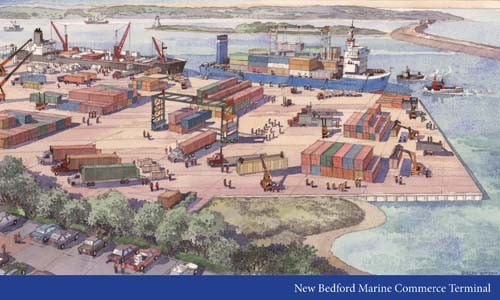
New Bedford has long touted its port as the largest in the U.S. fishing industry, but now local and Massachusetts officials say the city’s harbor is poised to become so much more.
A long-needed dredging project and promised repairs to a little-used rail link have breathed new economic life into the port at the mouth of the Acushnet River, even before last month’s announcement that New Bedford would be the staging site for Cape Wind’s massive offshore wind power project.
“We’ve been able to wake up again,” said Port Director Kristin Decas, who oversees several large terminals, piers and a marina along the waterfront. “We’re reactivating the shipping opportunities that have existing here in the past.”
In the process New Bedford has emerged as a serious competitor to Rhode Island’s Port of Davisville in the Quonset Business Park, which is also vying to become a hub of the fledging offshore wind industry.
Decas doesn’t deny there’s a certain amount of rivalry between the ports, but she insisted recently that they can coexist harmoniously.
The economic stakes are high.
New Bedford estimates that port activities such as seafood processing, ferry services and cruise-ship visits – as well as indirect commerce – keep 4,894 residents employed and pump $849 million into the local economy annually. That’s about 13 percent of New Bedford’s total economic output.
Now those numbers are set to grow. Experts forecast that the Cape Wind facility, slated to open in late 2012, will lead to as many as 1,200 new temporary and long-term jobs in southeastern Massachusetts.
Hoping to build on that foundation, the New Bedford Harbor Development Commission, the quasi-public agency that governs the port, is seeking to link with America’s Marine Highway, a federal initiative to encourage more cargo shipments on U.S. waterways instead of on its roads.
Earlier this year, New Bedford teamed with ports in Baltimore and Canaveral, Fla., to seek “marine highway project” status from the U.S. Maritime Administration. The designation would allow the ports to promote the short sea shipping connections between them as an alternative to trucking freight on Interstate 95.
Attracting more freight traffic into New Bedford actually would be a return to a not-so-distant past, according to Decas, the New Bedford Harbor Development Commission’s CEO and executive director.
In addition to the bustling fishing docks, the city had active cargo terminals until the 1970s, when the maritime industry shifted to using mega-sized ships that needed deeper water. Decades of industrial pollution that had settled to the bottom of New Bedford Harbor prevented dredging.
That has changed. The U.S. Environmental Protection Agency is in the midst of a long-term project to scoop contaminants from the waterway, which has cleared the way for the first maintenance dredging in 50 years.
The channel inside New Bedford’s hurricane barrier is now 30 feet deep, enough for large cargo ships, and that has raised New Bedford’s profile in the shipping industry, even on the international stage.
For instance, refrigerated ships carrying clementines from North Africa made 28 visits in 2009, up from 14 the year before, Decas noted. She foresees the number of shipping visits climbing again this year.
“We’re seeing it tick up because of the infrastructure improvements through dredging alone,” she said.
Officials are betting another amenity will make New Bedford all the more attractive: rail.
The state received $20 million from the federal Transportation Investment Generating Economic Recovery (TIGER) program to repair three nearby freight-line bridges. (The federal government rejected New Bedford’s application for an additional $16.4 million for various port upgrades.)
It’s hoped that the tracks will one day carry commuter rail service to New Bedford, but Decas said the improvements should help boost freight service to the port, too
Still, looking to take advantage of the refurbished rail bridges, Hyannis-based Mass Coastal Railroad has purchased from CSX Transportation the short-haul freight rights to 33 miles of track from New Bedford to Taunton.
“We’re putting an analysis together to identify what types of economic stimulus could be created through the reinvigorated rail activity,” Decas said. “There are markets there.”
The plans for a large staging facility for offshore wind power projects have attracted the most attention, and for good reason.
The project calls for the construction of a new $35 million terminal just inside the hurricane barrier that will feature a 1,000-foot-long bulkhead to accommodate larger ships and will include about 28 acres to lay out wind turbine blades for assembly. About nine acres of the proposed terminal will be created along the waterfront using clean fill from the harbor bottom.
Dubbed the Marine Commerce Terminal, the project’s price tag will be covered with a mix of state and local government money. Officials say the construction alone will create several hundred jobs. Then Cape Wind’s wind project will create hundreds more, as 130 turbines are installed off the Massachusetts coast and then maintained over the years.
Decas said the proposed terminal could be used for importing and exporting other goods and for other wind projects, too.
“We’re pursuing all opportunities that make sense,” she said.
Massachusetts’ leaders are excited about where New Bedford is positioned in the offshore wind industry.
“My counterparts [on] the East Coast wish they were us,” Gov. Deval L. Patrick said Oct. 20 in announcing plans for the Cape Wind assembly site. •










